Year :
2006
Title :
Biology
Exam :
JAMB Exam
Paper 1 | Objectives
41 - 50 of 50 Questions
| # | Question | Ans |
|---|---|---|
| 41. |
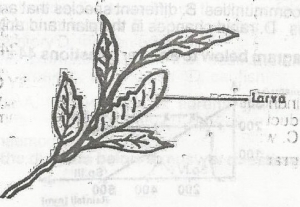 In the diagram, The economic importance of the larva is that it A. is eaten by birds B. develop into a moth C. resembles the plant on which it lives D. feeds on the leaves of crops |
D |
| 42. |
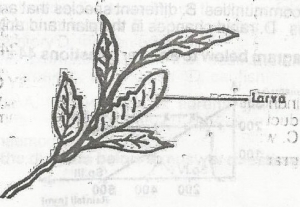 In the diagram, the type of adaptation shown in the larva is A. mimicry B. countershading C. flash colaration D. disruptive coloration |
D |
| 43. |
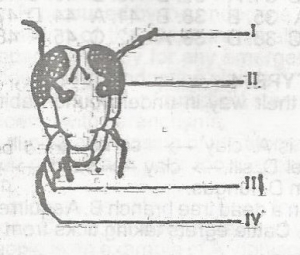 In the diagram, The maxillary palp is labelled A. ii B. iv C. i D. ii |
B |
| 44. |
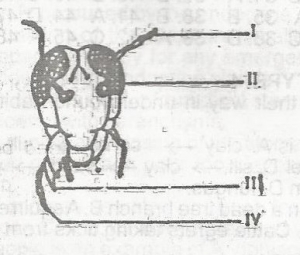 In the diagram, the structure labelled I is sensitive to A. light and touch B. chemicals only C. light only D. chemicals and touch |
A |
| 45. |
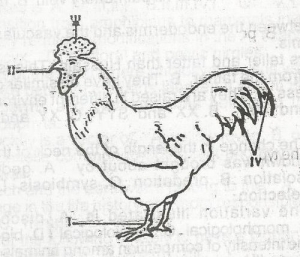 In the diagram, A unique characteristic that distinguishes the class of vertebrates represented from other vertebrates is the presence of A. two pair of limbs B. scales on the lower legs C. a pair of wings D. a covering of feathers |
D |
| 46. |
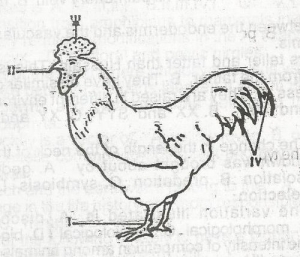 In the diagram, the structures used for offense and defense are labelled A. i and iv B. i and ii C. ii and iii D. iii and iv |
B |
| 47. |
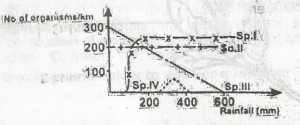 In the diagram, Which of the following can be decided from the distribution? A. species II is found only in locations where it rains all year round B. species III inreases in number as rainfall increases C. the distribution of species IV is not dependent on rainfall D. species I thrives under conditions of moderate to high rainfall |
D |
| 48. |
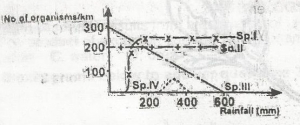 In the diagram, the species whose distribution is not affected by rainfall is A. ii B. iv C. i D. iii |
A |
| 49. |
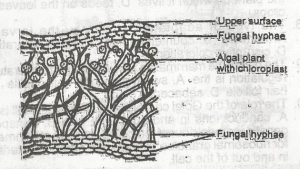 In the diagram, the importance of the association to the fungus is that it obtains A. a partner for reproduction B. anchorage from the algea C. oxgen and carbohydrates from the algae D. water and mineral salts from the algae |
C |
| 50. |
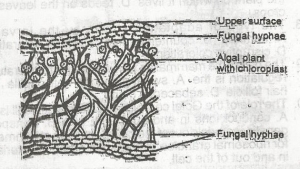 In the diagram, the association illustrated demonstrates A. parasitism B. commensalism C. saprophytism D. mutualism |
D |
| 41. |
 In the diagram, The economic importance of the larva is that it A. is eaten by birds B. develop into a moth C. resembles the plant on which it lives D. feeds on the leaves of crops |
D |
| 42. |
 In the diagram, the type of adaptation shown in the larva is A. mimicry B. countershading C. flash colaration D. disruptive coloration |
D |
| 43. |
 In the diagram, The maxillary palp is labelled A. ii B. iv C. i D. ii |
B |
| 44. |
 In the diagram, the structure labelled I is sensitive to A. light and touch B. chemicals only C. light only D. chemicals and touch |
A |
| 45. |
 In the diagram, A unique characteristic that distinguishes the class of vertebrates represented from other vertebrates is the presence of A. two pair of limbs B. scales on the lower legs C. a pair of wings D. a covering of feathers |
D |
| 46. |
 In the diagram, the structures used for offense and defense are labelled A. i and iv B. i and ii C. ii and iii D. iii and iv |
B |
| 47. |
 In the diagram, Which of the following can be decided from the distribution? A. species II is found only in locations where it rains all year round B. species III inreases in number as rainfall increases C. the distribution of species IV is not dependent on rainfall D. species I thrives under conditions of moderate to high rainfall |
D |
| 48. |
 In the diagram, the species whose distribution is not affected by rainfall is A. ii B. iv C. i D. iii |
A |
| 49. |
 In the diagram, the importance of the association to the fungus is that it obtains A. a partner for reproduction B. anchorage from the algea C. oxgen and carbohydrates from the algae D. water and mineral salts from the algae |
C |
| 50. |
 In the diagram, the association illustrated demonstrates A. parasitism B. commensalism C. saprophytism D. mutualism |
D |